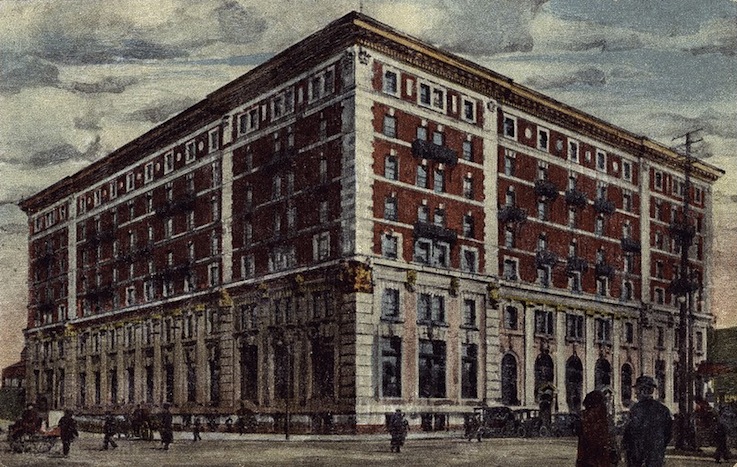The Canadian Pacific Railway had wanted to build a grand hotel at the corner of Higgins and Main for quite some time. This hotel, promised CP executive William Whyte in 1899, would be large, modern, and “commensurate with the import of the [CP rail]road and the dignity of Winnipeg.”
By 1903, the Winnipeg Telegram bemoaned the fact that the grand hotel was still “a thing of the dim and distant future.” It had gotten to the point, they wrote, where the rumours had become a standard joke for the minstrel shows and comedians passing through town.

The citizenry of the young city anxiously awaited the hotel not only because of the addition of a world class hostelry, but because of the outdating and embarrassing blight that it would replace. On the site of the future hotel stood a small train station, several small hotels (most of which were built quick and dirty in the real estate boom of 1881-’82) and what the the Telegram described as “Hebrew shops”: businesses that the early waves of German and Russian Jews had opened up along Higgins.
[related_content slugs=”winnipeg-doesnt-need-a-bigger-convention-centre,memories-from-skid-row-mcdinos,when-old-neighbourhoods-need-to-grow-up” description=”More from Robert Galston” position=”right”]
It was hoped then, as with so many urban renewal projects, that the hotel would act as a catalyst for more grand development on Main Street between Higgins and city hall, which still had the appearance of a ramshackle, faded boomtown. Never able to shake its status as a secondary business district characterized by its many notorious hotel saloons, Main Street was described by one publication from 1892 as “Winnipeg’s Bowery.”
The Royal Alexandra hotel, named after the Danish wife of Edward VII, finally opened its doors in 1906. Like the train station it was attached to (which is now the Aboriginal Centre of Winnipeg), the hotel was a sober and striking Beaux-Arts structure, built with Manitoba limestone and Wisconsin red brick.

The hotel quickly became an important landmark in the city. In addition to being the finest hotel (though facing stiff competition in that regard after the Fort Garry opened on Broadway in 1913), it was an important social and convention centre; for decades it was the busiest place in town on New Years’ Eve. In 1939, King George VI stayed there in 1939, and in 1951 Princess Elizabeth would also. As Queen Elizabeth II, she would stay there again in 1959.
***
However successul it was in its own right, the Royal Alex was unable to have much of a transformative effect on the rest of the neighbourhood. While Main Street saw a number of new structures built after 1906 — small office buildings, theatres, modern hotels — the old saloons and the seedy character as a skid row remained long after the Royal Alex did. The seven-storey hotel stood alone, overlooking the strip like an imposing Gibraltar of upper class respectability and architectural grandiosity.

Even as it remained a popular social centre and the place where royalty stayed, the fortunes of the grand old CP hotel were fading by the postwar era. Increasing decline of both passenger rail traffic and the surrounding neighbourhood caught up to the Royal Alex, and in 1967 — only eight years after the Queen stayed there — CP announced that the hotel would close its doors.
The building would stand vacant for several years under an uncertain future. A beloved landmark even in an age when cities cherished few of them, Mayor Steven Juba talked about the City buying the hotel and finding someone to redevelop it. But when CP got around to demolishing it in 1971, the City let them with little protest.

The Royal Alexandra stood for only 65 years. Much of its furnishing went to other CP hotels, or were sold off at public auctions. Exterior ornamentations, such as the lion’s heads that lorded over the second floor windows, were also salvaged. One lion head sits in the English Gardens as Assiniboine Park; another in a lane behind Bannatyne Avenue in the Exchange District.
The rest of the hotel, which had once embodied the fragile hopes of a young city, was carted off to the landfill.

___
Robert Galston likes to write about Winnipeg, urbanism, and other very, very exciting topics. Follow him on Twitter @riseandsprawl
For more, follow us on Twitter: @SpectatorTrib
